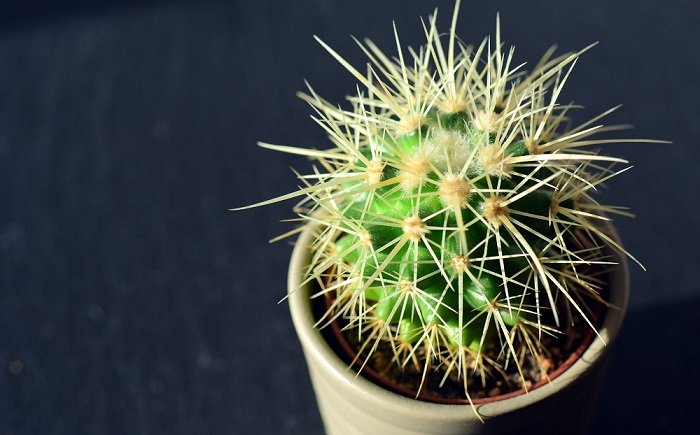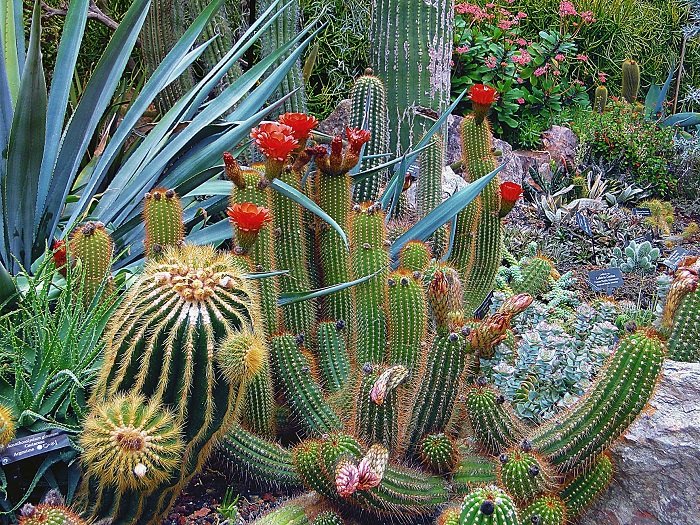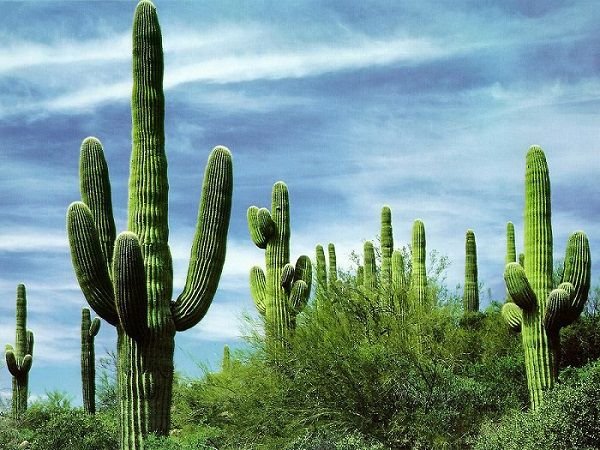When we hear the word cactus, we immediately imagine spines. This plant is always associated with them. This is one of the most amazing plant that appeared about 30-35 million years ago.
Cactus is pure American plant. It’s considered their homeland is the New World. Nearly 1500 species of cacti are inhabitants of the deserts and semi-deserts of Mexico and the southwest of USA. But cacti settled not only in hot and dry places. They meet in the north - from British Columbia (the westernmost province of Canada) to Nova Scotia (Eastern Canada), and in the south - until the end of South America. Some species are not afraid of winter cold, and others feel great in the high humidity of the tropics.
The word "cactus" comes from Greek κάκτος, which in classical Greek was used to identify some unknown for now plant. In 1737, scientist Carl Linnaeus introduced the name "cactus" to designate a particular plant species.
Cacti are divided into four groups:
- Subfamily Pereskioideae.
Subfamily includes one genus of shrubs with full leaves. Stems are smoothly round in cross section. This genus is considered an evolutionary link connecting cacti with deciduous plants.
- Subfamily Opuntioideae.
Subfamily unites plants characterized by clearly visible reduced leaves. Plants may have leaves when are young, but these are lost later. This subfamily has a special kind of spines – glochidia.
Glochidia are small, brittle spines, very sharp and provided with notches along the entire length and grow in large numbers by bundles around the areolas.
- Subfamily Maihuenioideae.
Plants of this subfamily have durable tiny juicy leaves of conical shape. Crassulean acid metabolism is wholly absent.
- Subfamily Cactoideae.
This subfamily unites all the remaining numerous types of cacti. Plants do not have leaves in any form. There are also no glochidia.
Cactus varied in shapes and sizes. Among them there are multi-meter giants, or low globular plants. Also there are cacti that hide most of their body under the ground.
In deserts where cactus grows, rainfall does not exceed 25cm (9,8inch) per year. In order to survive the cactus should use every drop, absorbing as much moisture as possible. In most species of cacti there is a powerful root and large lateral roots that are widely branched out and create a wide net. The drops of water enter the plant and contained in its fleshy stalk. Cactus that full of water can provides its moisture needs for two years or more. The water-filled plants are straight and round. But as the water supply depletes, cactus begins to wither and wrinkle. Some cacti lose more moisture from the side, which is turned to the sun, which causes the whole plant to bend.
The highest cacti.
The highest cacti are the plants of the genus Cereus. They are distinguished by a long cylindrical stalk and can reach 20 meters (65 ft) in height. Against the background of a green-blue stalk, gray, brown or black spines are beautifully stand out. Large greenish-white, white or pink flowers blossom at night. The fruits of this cactus are edible, yellow or red.
The highest cactus of South America is a giant carnegiea, also known as giant saguaro. It weighs 6-7 tons and grows to a height of 15 meters (49 ft). Up to 30 years, the saguaro does not rush to grow and reaches a maximum of a couple meters (ft). But then, the plant is directly transformed and adds almost a centimeter (0.3 inch) of growth every week. At this rate, by the age of 70, the cactus becomes like a high spiny tree with thick branches. The age of this giant can reach 150 years. This amazing plant grows in USA (Arizona and California) and in the north of Mexico. This cactus is notable not only for its size but also for its shape. The typical saguaro has only a few branches rising from the central column. The inner rigid woody skeleton of the plant maintains a lot of porous tissue that absorbs water. A thick waxy skin with plenty of thorns reduces the evaporation to an absolute minimum. Saguaro is full of deep folds. When the plant is saturated with water, it becomes much stretched. In this state, the saguaro can survive several arid years, but will grow only after the summer rains. In May-June there are white flowers appear on saguaro. Cactus protects flowers from the day’s heat and opens up only at night. Flowers are pollinated by white-winged pigeons. These pigeons often build their nests in the middle of the flowers. Also holes in thick skin of saguaro serve as a home for woodpeckers and tiny owls.
One of functions of cactus spines - they help keep water inside cactus and minimize evaporation.
Plant’s leaves play a role of pump. They create a suction force that causes water with dissolved substances to rise along roots and vessels. This process is called transpiration.
Transpiration is a process of water movement through a plant and it evaporation through the external organs of a plant, such as leaves, stems and flowers.
Water is essential for plant’s life. But if plant grows in a hot and dry climate, then it’s necessary to adjust to these conditions. To do so, just need to get rid of the leaves, thereby reducing the evaporating surface. Cactus did so. Their leaves turned into spines and the photosynthetic function is implementing by stem.
Areola and spines.
Areola is a strongly modified lateral bud on cacti out of which grow clusters of spines. Areola is an underdeveloped branch. It is a typical feature characteristic of all kinds of cacti. In the areoles usually develop spines and glochidia, providing a protective function.
One more function of spines is a protection of plant surfaces, especially in young plants. The spines protect plants from too bright sun rays and different injuries. And one more important function is to protect cactus from eating by animals.
As already mentioned above, cacti are home to many birds. And because of that some cacti have nectariferous spines. These spines release nectar to attract pollinators. Spines on fruits or dried leaves of inflorescences serve for spread of seeds with the help of birds and insects.
Records among spines.
Spines vary in length and amount. The more drying climate in which cactus lives, the more spines are on it. The most powerful spines have huge globular plants from Mexico and the south of USA – ferocactus. Their spines can reach a length up to 20cm (7.8inch) and a thickness up to 1cm (0.3inch).
The record holder among cactus’s thorns is a thorn 25cm (9.8inch) long.
References:
http://www.sbs.utexas.edu/mauseth/researchoncacti/Spines.htm
http://www.birdsandblooms.com/blog/why-are-cacti-covered-in-spines/
https://study.com/academy/lesson/saguaro-cactus-facts-lesson-for-kids.html





Great research. Nature has an answer for every situation...
Yes, it's true. Thank you!